Plan for Early Childhood and Primary School Children with Indigenous Education and Perspectives
VerifiedAdded on 2023/06/11
|11
|2223
|394
AI Summary
This article discusses the plan for early childhood and primary school children with indigenous education and perspectives. It includes strategies, resources, rationale, and curriculum aligned with Australian Education Council frameworks.
Contribute Materials
Your contribution can guide someone’s learning journey. Share your
documents today.
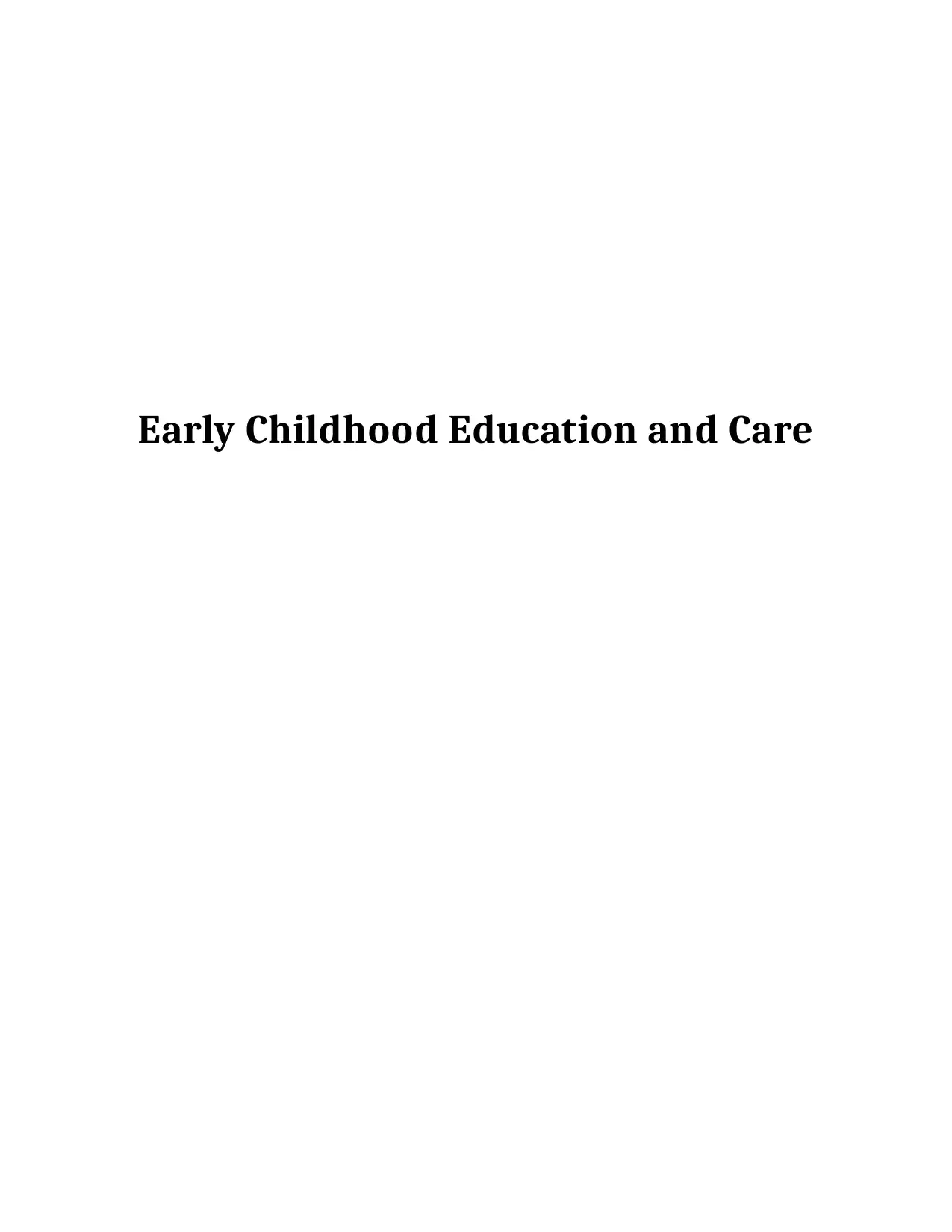
Early Childhood Education and Care
Secure Best Marks with AI Grader
Need help grading? Try our AI Grader for instant feedback on your assignments.
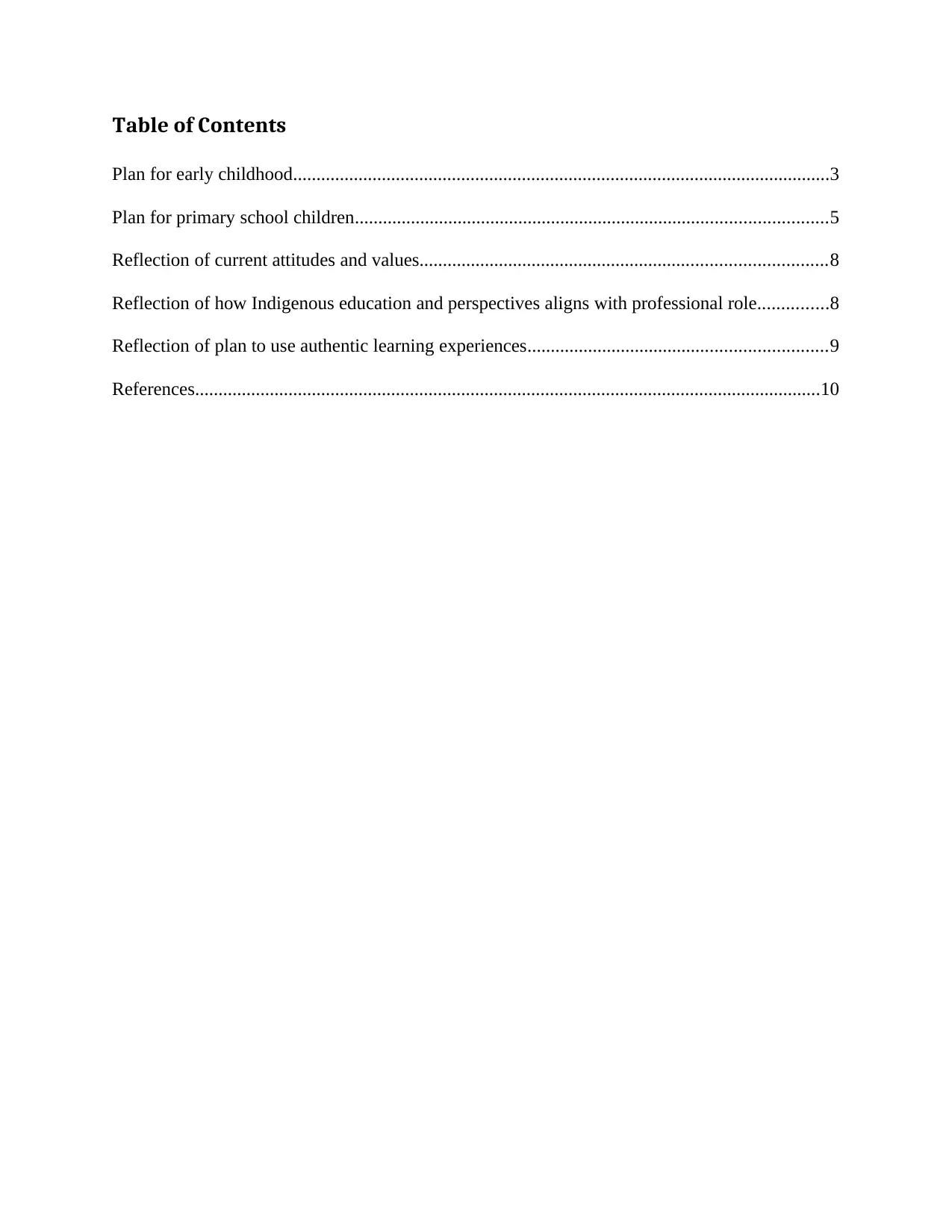
Table of Contents
Plan for early childhood...................................................................................................................3
Plan for primary school children.....................................................................................................5
Reflection of current attitudes and values.......................................................................................8
Reflection of how Indigenous education and perspectives aligns with professional role...............8
Reflection of plan to use authentic learning experiences................................................................9
References......................................................................................................................................10
Plan for early childhood...................................................................................................................3
Plan for primary school children.....................................................................................................5
Reflection of current attitudes and values.......................................................................................8
Reflection of how Indigenous education and perspectives aligns with professional role...............8
Reflection of plan to use authentic learning experiences................................................................9
References......................................................................................................................................10
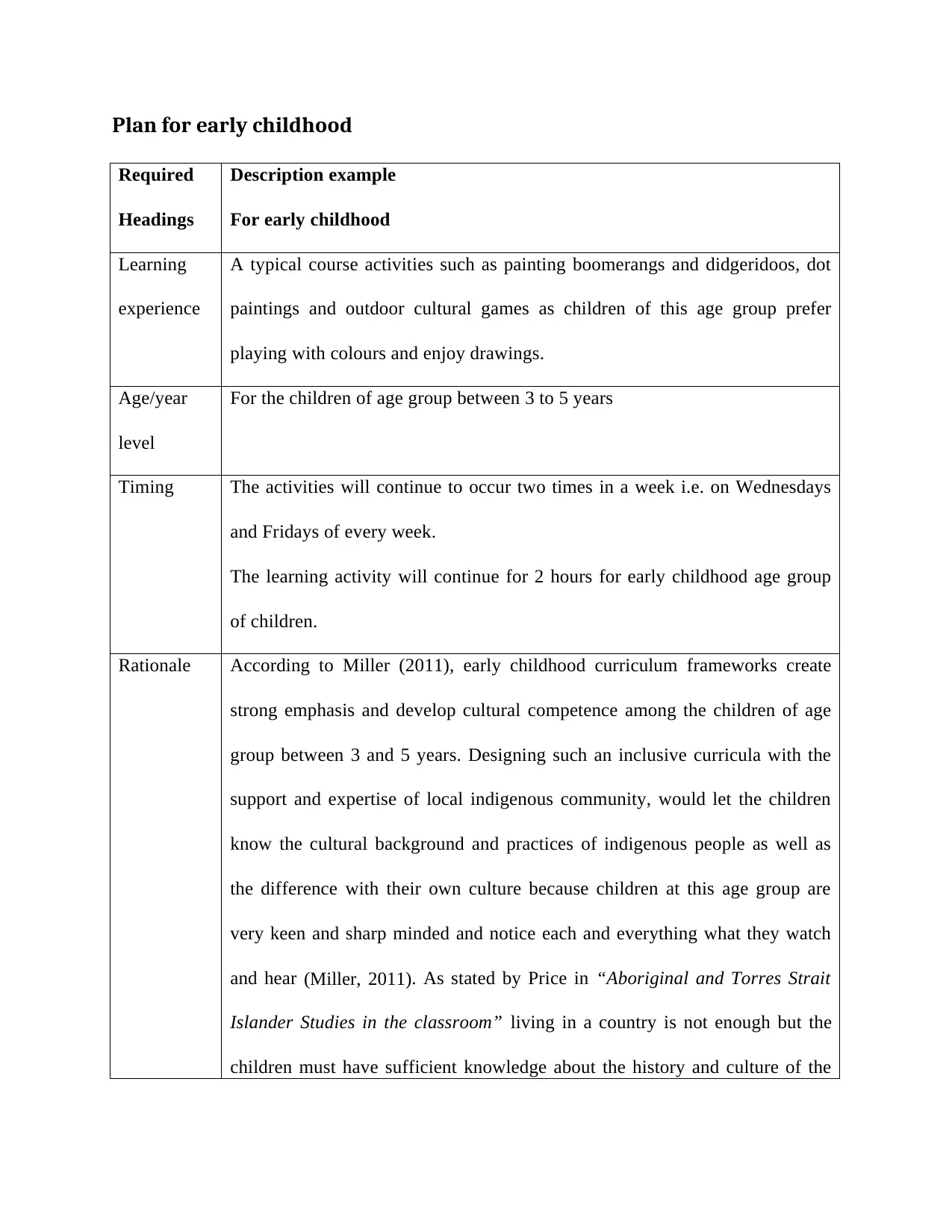
Plan for early childhood
Required
Headings
Description example
For early childhood
Learning
experience
A typical course activities such as painting boomerangs and didgeridoos, dot
paintings and outdoor cultural games as children of this age group prefer
playing with colours and enjoy drawings.
Age/year
level
For the children of age group between 3 to 5 years
Timing The activities will continue to occur two times in a week i.e. on Wednesdays
and Fridays of every week.
The learning activity will continue for 2 hours for early childhood age group
of children.
Rationale According to Miller (2011), early childhood curriculum frameworks create
strong emphasis and develop cultural competence among the children of age
group between 3 and 5 years. Designing such an inclusive curricula with the
support and expertise of local indigenous community, would let the children
know the cultural background and practices of indigenous people as well as
the difference with their own culture because children at this age group are
very keen and sharp minded and notice each and everything what they watch
and hear (Miller, 2011). As stated by Price in “Aboriginal and Torres Strait
Islander Studies in the classroom” living in a country is not enough but the
children must have sufficient knowledge about the history and culture of the
Required
Headings
Description example
For early childhood
Learning
experience
A typical course activities such as painting boomerangs and didgeridoos, dot
paintings and outdoor cultural games as children of this age group prefer
playing with colours and enjoy drawings.
Age/year
level
For the children of age group between 3 to 5 years
Timing The activities will continue to occur two times in a week i.e. on Wednesdays
and Fridays of every week.
The learning activity will continue for 2 hours for early childhood age group
of children.
Rationale According to Miller (2011), early childhood curriculum frameworks create
strong emphasis and develop cultural competence among the children of age
group between 3 and 5 years. Designing such an inclusive curricula with the
support and expertise of local indigenous community, would let the children
know the cultural background and practices of indigenous people as well as
the difference with their own culture because children at this age group are
very keen and sharp minded and notice each and everything what they watch
and hear (Miller, 2011). As stated by Price in “Aboriginal and Torres Strait
Islander Studies in the classroom” living in a country is not enough but the
children must have sufficient knowledge about the history and culture of the
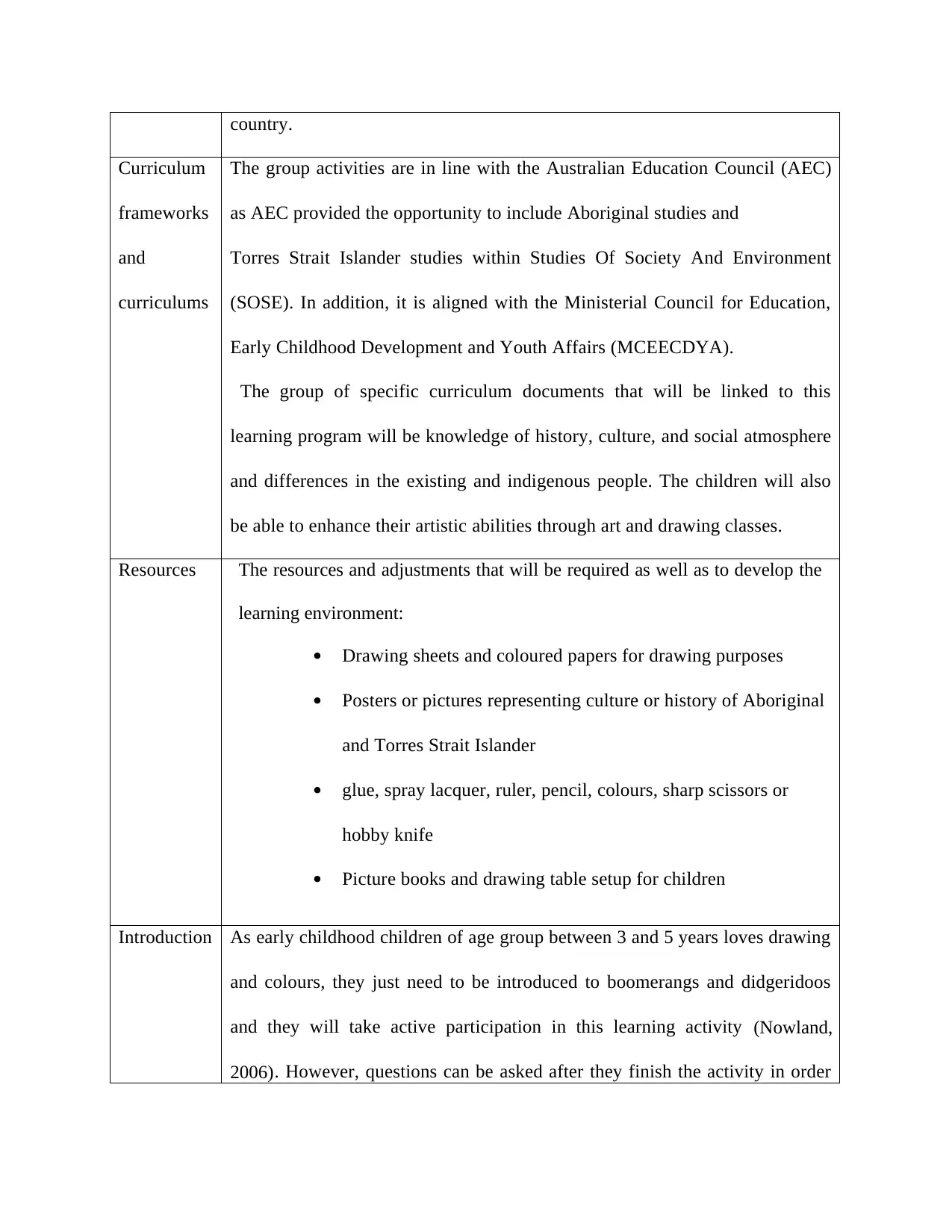
country.
Curriculum
frameworks
and
curriculums
The group activities are in line with the Australian Education Council (AEC)
as AEC provided the opportunity to include Aboriginal studies and
Torres Strait Islander studies within Studies Of Society And Environment
(SOSE). In addition, it is aligned with the Ministerial Council for Education,
Early Childhood Development and Youth Affairs (MCEECDYA).
The group of specific curriculum documents that will be linked to this
learning program will be knowledge of history, culture, and social atmosphere
and differences in the existing and indigenous people. The children will also
be able to enhance their artistic abilities through art and drawing classes.
Resources The resources and adjustments that will be required as well as to develop the
learning environment:
Drawing sheets and coloured papers for drawing purposes
Posters or pictures representing culture or history of Aboriginal
and Torres Strait Islander
glue, spray lacquer, ruler, pencil, colours, sharp scissors or
hobby knife
Picture books and drawing table setup for children
Introduction As early childhood children of age group between 3 and 5 years loves drawing
and colours, they just need to be introduced to boomerangs and didgeridoos
and they will take active participation in this learning activity (Nowland,
2006). However, questions can be asked after they finish the activity in order
Curriculum
frameworks
and
curriculums
The group activities are in line with the Australian Education Council (AEC)
as AEC provided the opportunity to include Aboriginal studies and
Torres Strait Islander studies within Studies Of Society And Environment
(SOSE). In addition, it is aligned with the Ministerial Council for Education,
Early Childhood Development and Youth Affairs (MCEECDYA).
The group of specific curriculum documents that will be linked to this
learning program will be knowledge of history, culture, and social atmosphere
and differences in the existing and indigenous people. The children will also
be able to enhance their artistic abilities through art and drawing classes.
Resources The resources and adjustments that will be required as well as to develop the
learning environment:
Drawing sheets and coloured papers for drawing purposes
Posters or pictures representing culture or history of Aboriginal
and Torres Strait Islander
glue, spray lacquer, ruler, pencil, colours, sharp scissors or
hobby knife
Picture books and drawing table setup for children
Introduction As early childhood children of age group between 3 and 5 years loves drawing
and colours, they just need to be introduced to boomerangs and didgeridoos
and they will take active participation in this learning activity (Nowland,
2006). However, questions can be asked after they finish the activity in order
Secure Best Marks with AI Grader
Need help grading? Try our AI Grader for instant feedback on your assignments.
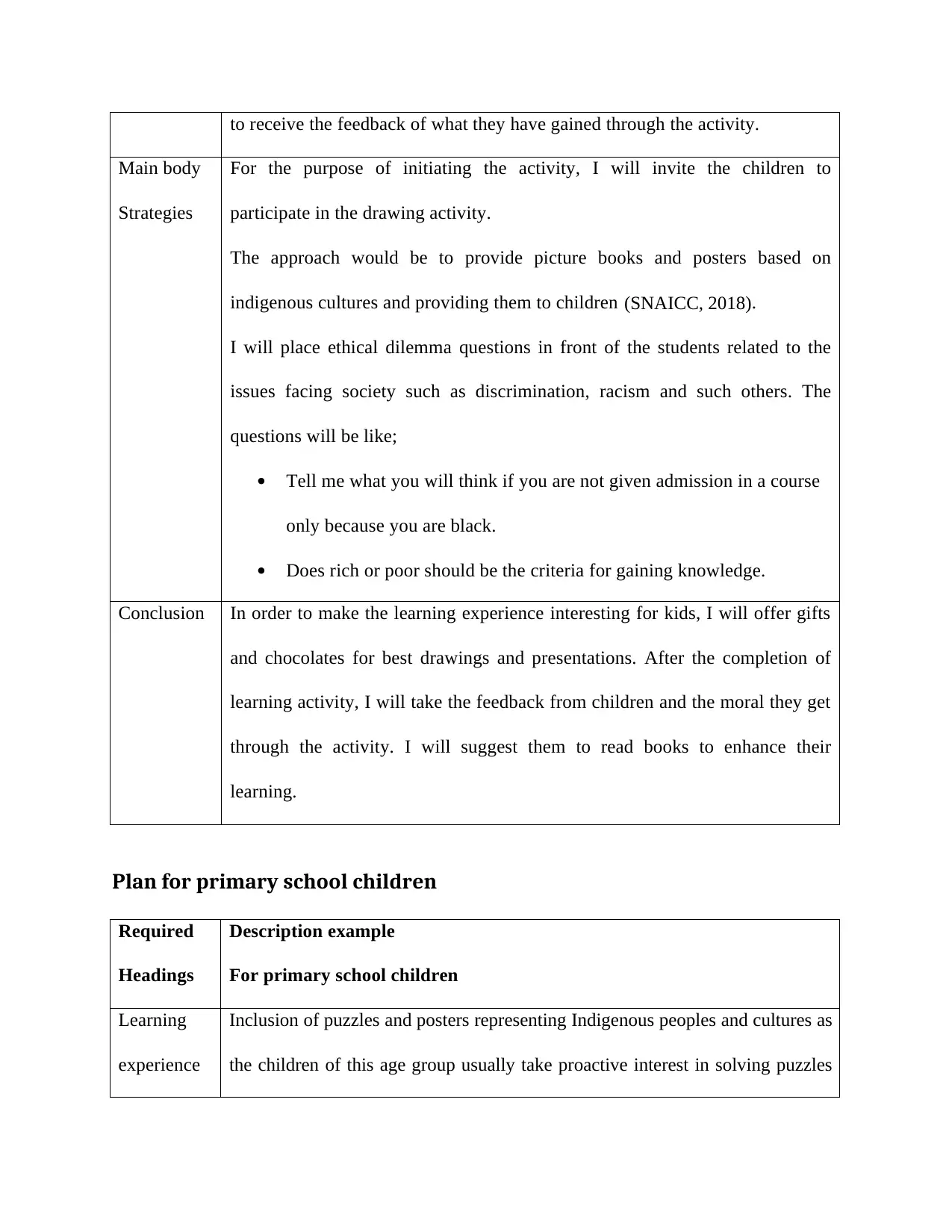
to receive the feedback of what they have gained through the activity.
Main body
Strategies
For the purpose of initiating the activity, I will invite the children to
participate in the drawing activity.
The approach would be to provide picture books and posters based on
indigenous cultures and providing them to children (SNAICC, 2018).
I will place ethical dilemma questions in front of the students related to the
issues facing society such as discrimination, racism and such others. The
questions will be like;
Tell me what you will think if you are not given admission in a course
only because you are black.
Does rich or poor should be the criteria for gaining knowledge.
Conclusion In order to make the learning experience interesting for kids, I will offer gifts
and chocolates for best drawings and presentations. After the completion of
learning activity, I will take the feedback from children and the moral they get
through the activity. I will suggest them to read books to enhance their
learning.
Plan for primary school children
Required
Headings
Description example
For primary school children
Learning
experience
Inclusion of puzzles and posters representing Indigenous peoples and cultures as
the children of this age group usually take proactive interest in solving puzzles
Main body
Strategies
For the purpose of initiating the activity, I will invite the children to
participate in the drawing activity.
The approach would be to provide picture books and posters based on
indigenous cultures and providing them to children (SNAICC, 2018).
I will place ethical dilemma questions in front of the students related to the
issues facing society such as discrimination, racism and such others. The
questions will be like;
Tell me what you will think if you are not given admission in a course
only because you are black.
Does rich or poor should be the criteria for gaining knowledge.
Conclusion In order to make the learning experience interesting for kids, I will offer gifts
and chocolates for best drawings and presentations. After the completion of
learning activity, I will take the feedback from children and the moral they get
through the activity. I will suggest them to read books to enhance their
learning.
Plan for primary school children
Required
Headings
Description example
For primary school children
Learning
experience
Inclusion of puzzles and posters representing Indigenous peoples and cultures as
the children of this age group usually take proactive interest in solving puzzles
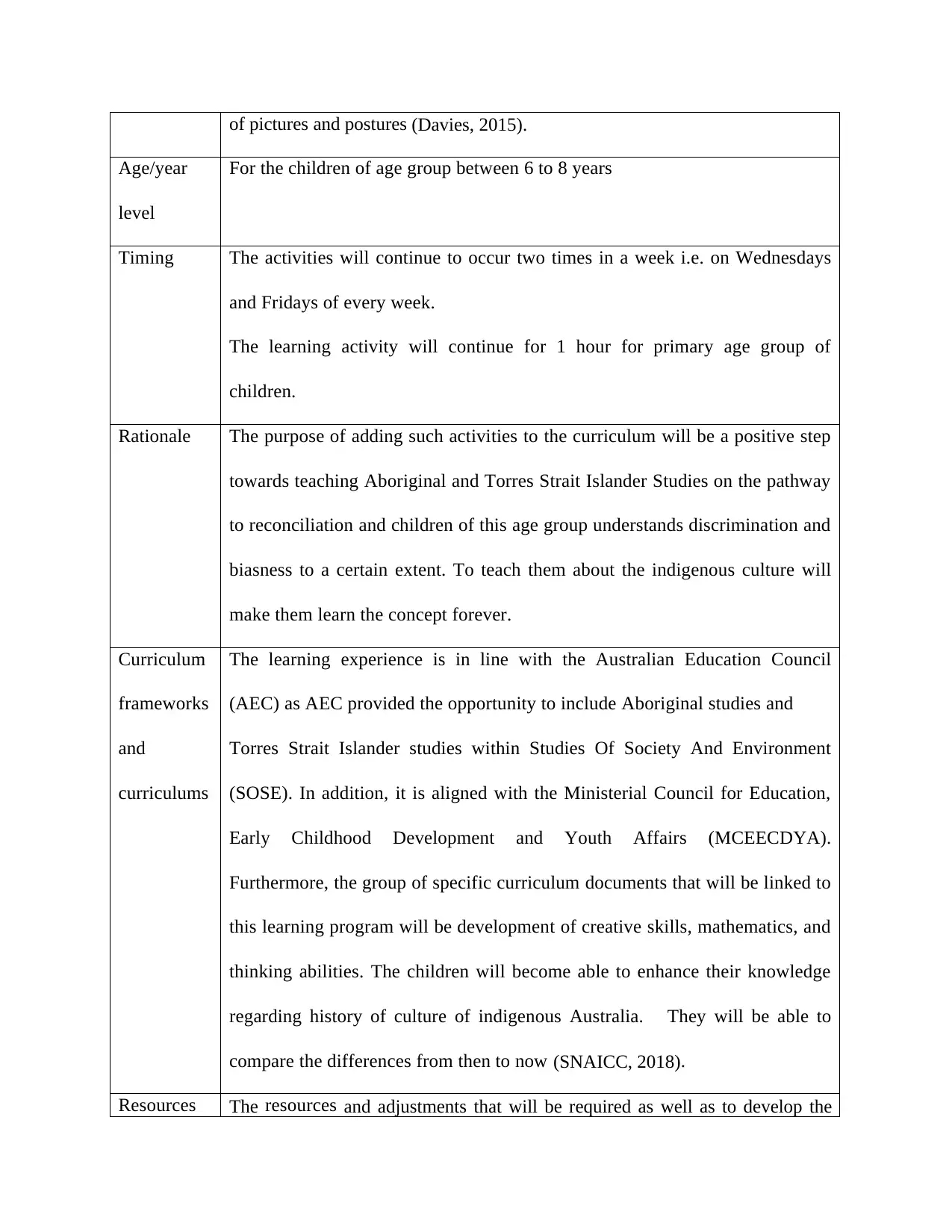
of pictures and postures (Davies, 2015).
Age/year
level
For the children of age group between 6 to 8 years
Timing The activities will continue to occur two times in a week i.e. on Wednesdays
and Fridays of every week.
The learning activity will continue for 1 hour for primary age group of
children.
Rationale The purpose of adding such activities to the curriculum will be a positive step
towards teaching Aboriginal and Torres Strait Islander Studies on the pathway
to reconciliation and children of this age group understands discrimination and
biasness to a certain extent. To teach them about the indigenous culture will
make them learn the concept forever.
Curriculum
frameworks
and
curriculums
The learning experience is in line with the Australian Education Council
(AEC) as AEC provided the opportunity to include Aboriginal studies and
Torres Strait Islander studies within Studies Of Society And Environment
(SOSE). In addition, it is aligned with the Ministerial Council for Education,
Early Childhood Development and Youth Affairs (MCEECDYA).
Furthermore, the group of specific curriculum documents that will be linked to
this learning program will be development of creative skills, mathematics, and
thinking abilities. The children will become able to enhance their knowledge
regarding history of culture of indigenous Australia. They will be able to
compare the differences from then to now (SNAICC, 2018).
Resources The resources and adjustments that will be required as well as to develop the
Age/year
level
For the children of age group between 6 to 8 years
Timing The activities will continue to occur two times in a week i.e. on Wednesdays
and Fridays of every week.
The learning activity will continue for 1 hour for primary age group of
children.
Rationale The purpose of adding such activities to the curriculum will be a positive step
towards teaching Aboriginal and Torres Strait Islander Studies on the pathway
to reconciliation and children of this age group understands discrimination and
biasness to a certain extent. To teach them about the indigenous culture will
make them learn the concept forever.
Curriculum
frameworks
and
curriculums
The learning experience is in line with the Australian Education Council
(AEC) as AEC provided the opportunity to include Aboriginal studies and
Torres Strait Islander studies within Studies Of Society And Environment
(SOSE). In addition, it is aligned with the Ministerial Council for Education,
Early Childhood Development and Youth Affairs (MCEECDYA).
Furthermore, the group of specific curriculum documents that will be linked to
this learning program will be development of creative skills, mathematics, and
thinking abilities. The children will become able to enhance their knowledge
regarding history of culture of indigenous Australia. They will be able to
compare the differences from then to now (SNAICC, 2018).
Resources The resources and adjustments that will be required as well as to develop the
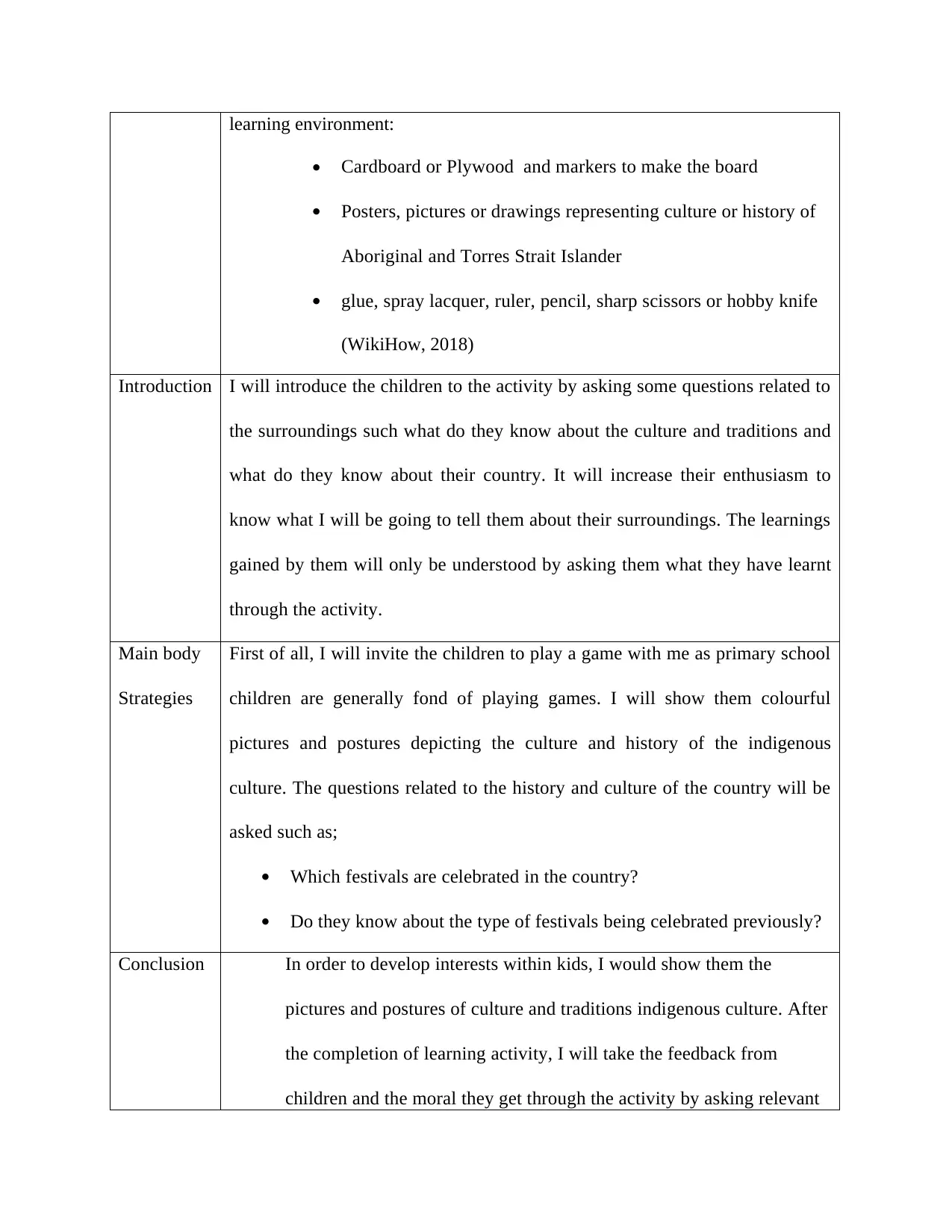
learning environment:
Cardboard or Plywood and markers to make the board
Posters, pictures or drawings representing culture or history of
Aboriginal and Torres Strait Islander
glue, spray lacquer, ruler, pencil, sharp scissors or hobby knife
(WikiHow, 2018)
Introduction I will introduce the children to the activity by asking some questions related to
the surroundings such what do they know about the culture and traditions and
what do they know about their country. It will increase their enthusiasm to
know what I will be going to tell them about their surroundings. The learnings
gained by them will only be understood by asking them what they have learnt
through the activity.
Main body
Strategies
First of all, I will invite the children to play a game with me as primary school
children are generally fond of playing games. I will show them colourful
pictures and postures depicting the culture and history of the indigenous
culture. The questions related to the history and culture of the country will be
asked such as;
Which festivals are celebrated in the country?
Do they know about the type of festivals being celebrated previously?
Conclusion In order to develop interests within kids, I would show them the
pictures and postures of culture and traditions indigenous culture. After
the completion of learning activity, I will take the feedback from
children and the moral they get through the activity by asking relevant
Cardboard or Plywood and markers to make the board
Posters, pictures or drawings representing culture or history of
Aboriginal and Torres Strait Islander
glue, spray lacquer, ruler, pencil, sharp scissors or hobby knife
(WikiHow, 2018)
Introduction I will introduce the children to the activity by asking some questions related to
the surroundings such what do they know about the culture and traditions and
what do they know about their country. It will increase their enthusiasm to
know what I will be going to tell them about their surroundings. The learnings
gained by them will only be understood by asking them what they have learnt
through the activity.
Main body
Strategies
First of all, I will invite the children to play a game with me as primary school
children are generally fond of playing games. I will show them colourful
pictures and postures depicting the culture and history of the indigenous
culture. The questions related to the history and culture of the country will be
asked such as;
Which festivals are celebrated in the country?
Do they know about the type of festivals being celebrated previously?
Conclusion In order to develop interests within kids, I would show them the
pictures and postures of culture and traditions indigenous culture. After
the completion of learning activity, I will take the feedback from
children and the moral they get through the activity by asking relevant
Paraphrase This Document
Need a fresh take? Get an instant paraphrase of this document with our AI Paraphraser
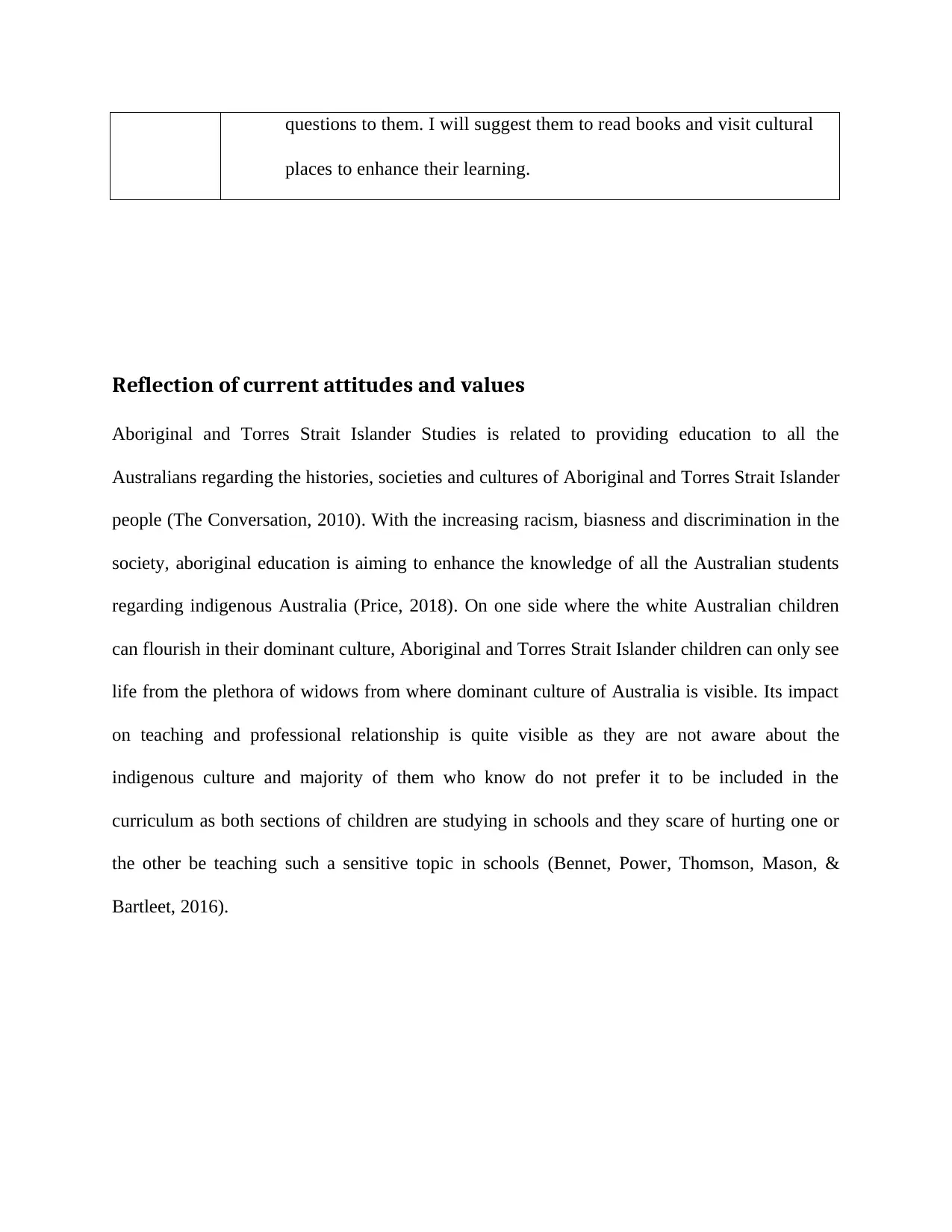
questions to them. I will suggest them to read books and visit cultural
places to enhance their learning.
Reflection of current attitudes and values
Aboriginal and Torres Strait Islander Studies is related to providing education to all the
Australians regarding the histories, societies and cultures of Aboriginal and Torres Strait Islander
people (The Conversation, 2010). With the increasing racism, biasness and discrimination in the
society, aboriginal education is aiming to enhance the knowledge of all the Australian students
regarding indigenous Australia (Price, 2018). On one side where the white Australian children
can flourish in their dominant culture, Aboriginal and Torres Strait Islander children can only see
life from the plethora of widows from where dominant culture of Australia is visible. Its impact
on teaching and professional relationship is quite visible as they are not aware about the
indigenous culture and majority of them who know do not prefer it to be included in the
curriculum as both sections of children are studying in schools and they scare of hurting one or
the other be teaching such a sensitive topic in schools (Bennet, Power, Thomson, Mason, &
Bartleet, 2016).
places to enhance their learning.
Reflection of current attitudes and values
Aboriginal and Torres Strait Islander Studies is related to providing education to all the
Australians regarding the histories, societies and cultures of Aboriginal and Torres Strait Islander
people (The Conversation, 2010). With the increasing racism, biasness and discrimination in the
society, aboriginal education is aiming to enhance the knowledge of all the Australian students
regarding indigenous Australia (Price, 2018). On one side where the white Australian children
can flourish in their dominant culture, Aboriginal and Torres Strait Islander children can only see
life from the plethora of widows from where dominant culture of Australia is visible. Its impact
on teaching and professional relationship is quite visible as they are not aware about the
indigenous culture and majority of them who know do not prefer it to be included in the
curriculum as both sections of children are studying in schools and they scare of hurting one or
the other be teaching such a sensitive topic in schools (Bennet, Power, Thomson, Mason, &
Bartleet, 2016).
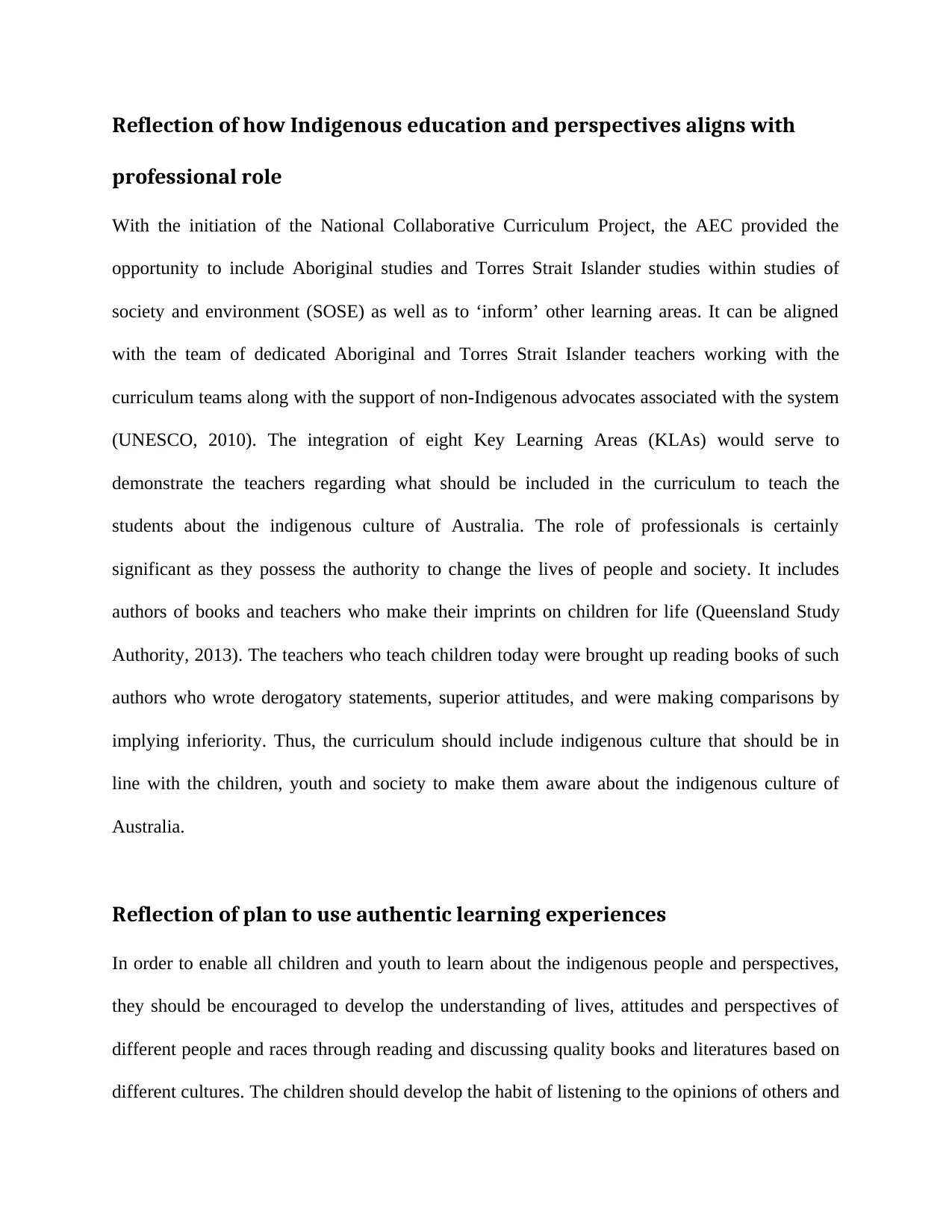
Reflection of how Indigenous education and perspectives aligns with
professional role
With the initiation of the National Collaborative Curriculum Project, the AEC provided the
opportunity to include Aboriginal studies and Torres Strait Islander studies within studies of
society and environment (SOSE) as well as to ‘inform’ other learning areas. It can be aligned
with the team of dedicated Aboriginal and Torres Strait Islander teachers working with the
curriculum teams along with the support of non-Indigenous advocates associated with the system
(UNESCO, 2010). The integration of eight Key Learning Areas (KLAs) would serve to
demonstrate the teachers regarding what should be included in the curriculum to teach the
students about the indigenous culture of Australia. The role of professionals is certainly
significant as they possess the authority to change the lives of people and society. It includes
authors of books and teachers who make their imprints on children for life (Queensland Study
Authority, 2013). The teachers who teach children today were brought up reading books of such
authors who wrote derogatory statements, superior attitudes, and were making comparisons by
implying inferiority. Thus, the curriculum should include indigenous culture that should be in
line with the children, youth and society to make them aware about the indigenous culture of
Australia.
Reflection of plan to use authentic learning experiences
In order to enable all children and youth to learn about the indigenous people and perspectives,
they should be encouraged to develop the understanding of lives, attitudes and perspectives of
different people and races through reading and discussing quality books and literatures based on
different cultures. The children should develop the habit of listening to the opinions of others and
professional role
With the initiation of the National Collaborative Curriculum Project, the AEC provided the
opportunity to include Aboriginal studies and Torres Strait Islander studies within studies of
society and environment (SOSE) as well as to ‘inform’ other learning areas. It can be aligned
with the team of dedicated Aboriginal and Torres Strait Islander teachers working with the
curriculum teams along with the support of non-Indigenous advocates associated with the system
(UNESCO, 2010). The integration of eight Key Learning Areas (KLAs) would serve to
demonstrate the teachers regarding what should be included in the curriculum to teach the
students about the indigenous culture of Australia. The role of professionals is certainly
significant as they possess the authority to change the lives of people and society. It includes
authors of books and teachers who make their imprints on children for life (Queensland Study
Authority, 2013). The teachers who teach children today were brought up reading books of such
authors who wrote derogatory statements, superior attitudes, and were making comparisons by
implying inferiority. Thus, the curriculum should include indigenous culture that should be in
line with the children, youth and society to make them aware about the indigenous culture of
Australia.
Reflection of plan to use authentic learning experiences
In order to enable all children and youth to learn about the indigenous people and perspectives,
they should be encouraged to develop the understanding of lives, attitudes and perspectives of
different people and races through reading and discussing quality books and literatures based on
different cultures. The children should develop the habit of listening to the opinions of others and
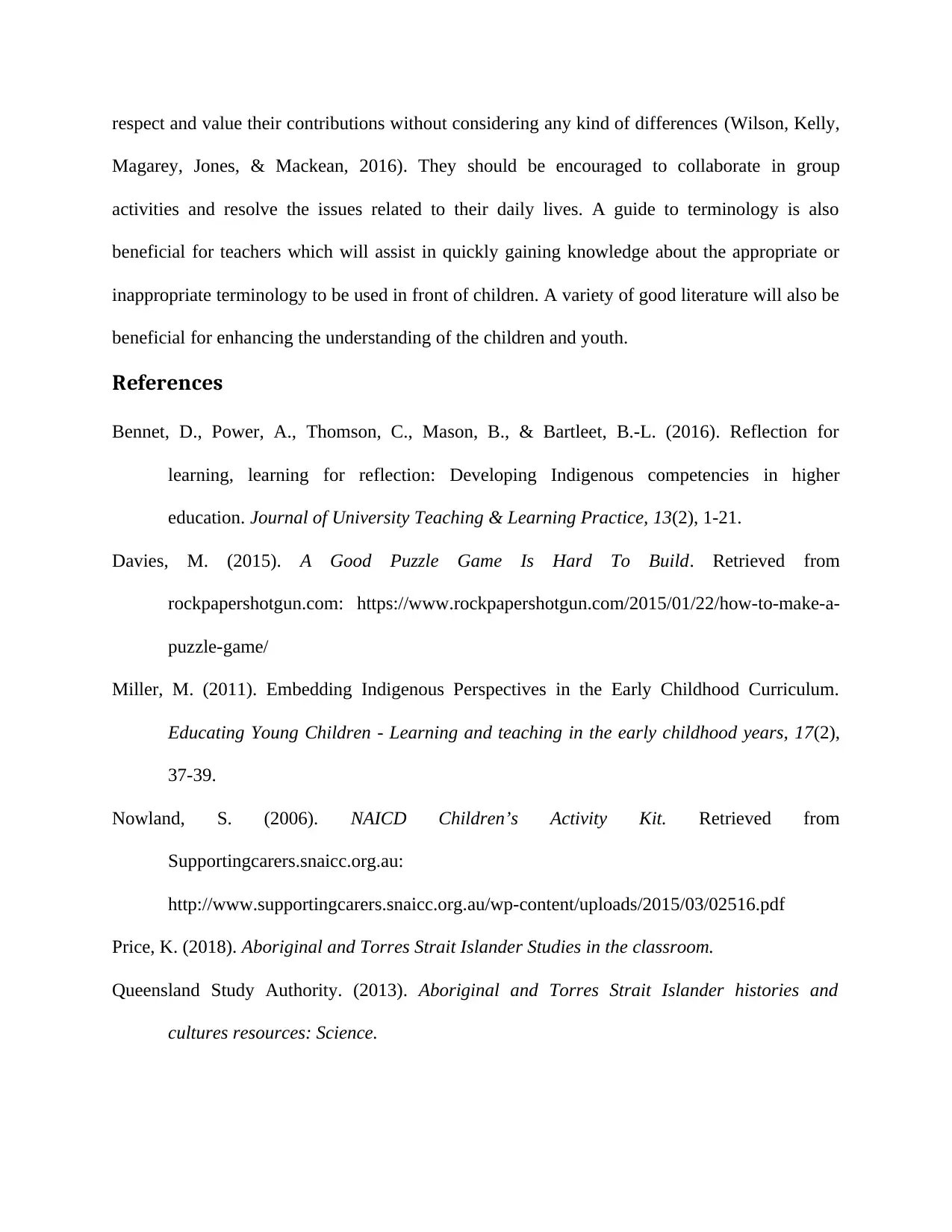
respect and value their contributions without considering any kind of differences (Wilson, Kelly,
Magarey, Jones, & Mackean, 2016). They should be encouraged to collaborate in group
activities and resolve the issues related to their daily lives. A guide to terminology is also
beneficial for teachers which will assist in quickly gaining knowledge about the appropriate or
inappropriate terminology to be used in front of children. A variety of good literature will also be
beneficial for enhancing the understanding of the children and youth.
References
Bennet, D., Power, A., Thomson, C., Mason, B., & Bartleet, B.-L. (2016). Reflection for
learning, learning for reflection: Developing Indigenous competencies in higher
education. Journal of University Teaching & Learning Practice, 13(2), 1-21.
Davies, M. (2015). A Good Puzzle Game Is Hard To Build. Retrieved from
rockpapershotgun.com: https://www.rockpapershotgun.com/2015/01/22/how-to-make-a-
puzzle-game/
Miller, M. (2011). Embedding Indigenous Perspectives in the Early Childhood Curriculum.
Educating Young Children - Learning and teaching in the early childhood years, 17(2),
37-39.
Nowland, S. (2006). NAICD Children’s Activity Kit. Retrieved from
Supportingcarers.snaicc.org.au:
http://www.supportingcarers.snaicc.org.au/wp-content/uploads/2015/03/02516.pdf
Price, K. (2018). Aboriginal and Torres Strait Islander Studies in the classroom.
Queensland Study Authority. (2013). Aboriginal and Torres Strait Islander histories and
cultures resources: Science.
Magarey, Jones, & Mackean, 2016). They should be encouraged to collaborate in group
activities and resolve the issues related to their daily lives. A guide to terminology is also
beneficial for teachers which will assist in quickly gaining knowledge about the appropriate or
inappropriate terminology to be used in front of children. A variety of good literature will also be
beneficial for enhancing the understanding of the children and youth.
References
Bennet, D., Power, A., Thomson, C., Mason, B., & Bartleet, B.-L. (2016). Reflection for
learning, learning for reflection: Developing Indigenous competencies in higher
education. Journal of University Teaching & Learning Practice, 13(2), 1-21.
Davies, M. (2015). A Good Puzzle Game Is Hard To Build. Retrieved from
rockpapershotgun.com: https://www.rockpapershotgun.com/2015/01/22/how-to-make-a-
puzzle-game/
Miller, M. (2011). Embedding Indigenous Perspectives in the Early Childhood Curriculum.
Educating Young Children - Learning and teaching in the early childhood years, 17(2),
37-39.
Nowland, S. (2006). NAICD Children’s Activity Kit. Retrieved from
Supportingcarers.snaicc.org.au:
http://www.supportingcarers.snaicc.org.au/wp-content/uploads/2015/03/02516.pdf
Price, K. (2018). Aboriginal and Torres Strait Islander Studies in the classroom.
Queensland Study Authority. (2013). Aboriginal and Torres Strait Islander histories and
cultures resources: Science.
Secure Best Marks with AI Grader
Need help grading? Try our AI Grader for instant feedback on your assignments.
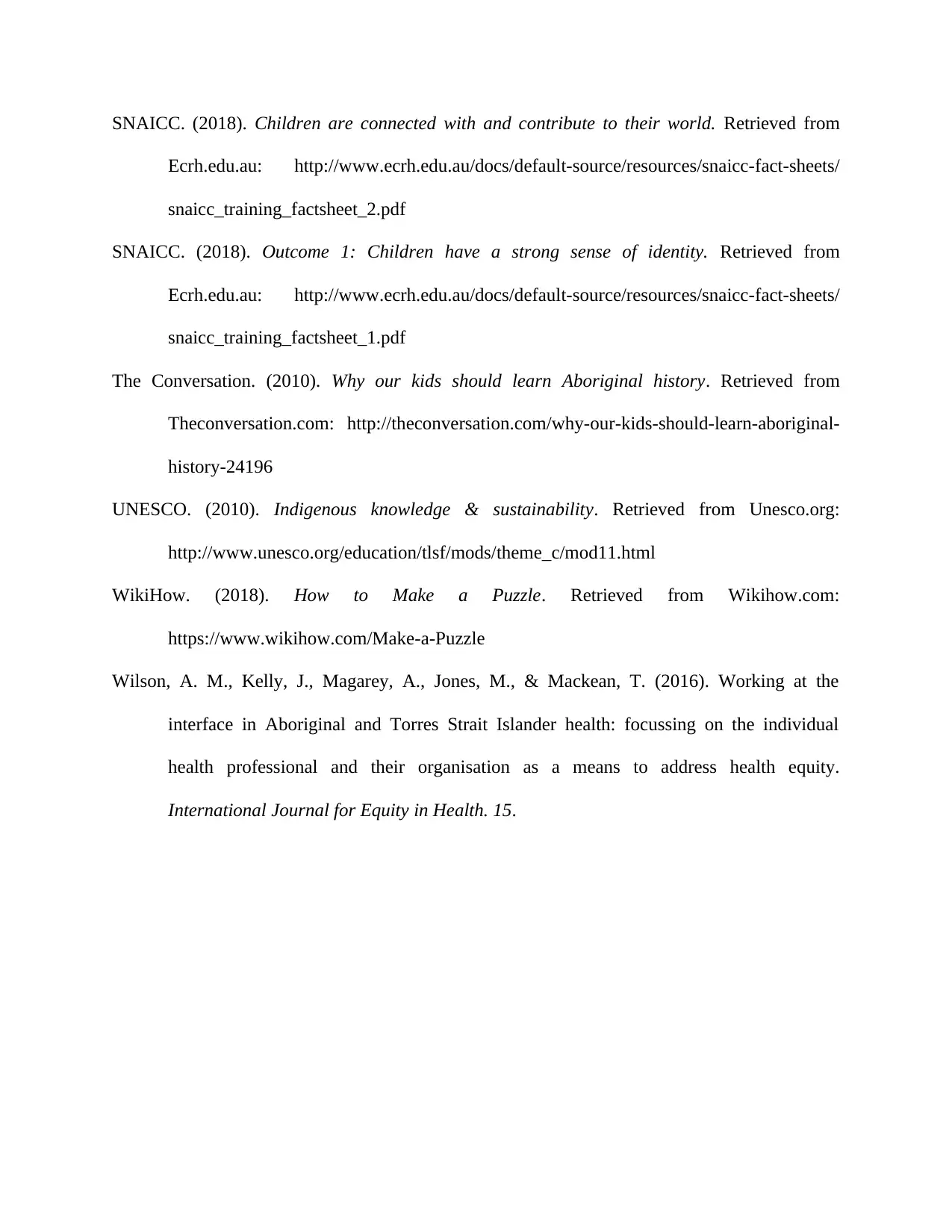
SNAICC. (2018). Children are connected with and contribute to their world. Retrieved from
Ecrh.edu.au: http://www.ecrh.edu.au/docs/default-source/resources/snaicc-fact-sheets/
snaicc_training_factsheet_2.pdf
SNAICC. (2018). Outcome 1: Children have a strong sense of identity. Retrieved from
Ecrh.edu.au: http://www.ecrh.edu.au/docs/default-source/resources/snaicc-fact-sheets/
snaicc_training_factsheet_1.pdf
The Conversation. (2010). Why our kids should learn Aboriginal history. Retrieved from
Theconversation.com: http://theconversation.com/why-our-kids-should-learn-aboriginal-
history-24196
UNESCO. (2010). Indigenous knowledge & sustainability. Retrieved from Unesco.org:
http://www.unesco.org/education/tlsf/mods/theme_c/mod11.html
WikiHow. (2018). How to Make a Puzzle. Retrieved from Wikihow.com:
https://www.wikihow.com/Make-a-Puzzle
Wilson, A. M., Kelly, J., Magarey, A., Jones, M., & Mackean, T. (2016). Working at the
interface in Aboriginal and Torres Strait Islander health: focussing on the individual
health professional and their organisation as a means to address health equity.
International Journal for Equity in Health. 15.
Ecrh.edu.au: http://www.ecrh.edu.au/docs/default-source/resources/snaicc-fact-sheets/
snaicc_training_factsheet_2.pdf
SNAICC. (2018). Outcome 1: Children have a strong sense of identity. Retrieved from
Ecrh.edu.au: http://www.ecrh.edu.au/docs/default-source/resources/snaicc-fact-sheets/
snaicc_training_factsheet_1.pdf
The Conversation. (2010). Why our kids should learn Aboriginal history. Retrieved from
Theconversation.com: http://theconversation.com/why-our-kids-should-learn-aboriginal-
history-24196
UNESCO. (2010). Indigenous knowledge & sustainability. Retrieved from Unesco.org:
http://www.unesco.org/education/tlsf/mods/theme_c/mod11.html
WikiHow. (2018). How to Make a Puzzle. Retrieved from Wikihow.com:
https://www.wikihow.com/Make-a-Puzzle
Wilson, A. M., Kelly, J., Magarey, A., Jones, M., & Mackean, T. (2016). Working at the
interface in Aboriginal and Torres Strait Islander health: focussing on the individual
health professional and their organisation as a means to address health equity.
International Journal for Equity in Health. 15.
1 out of 11
Related Documents
Your All-in-One AI-Powered Toolkit for Academic Success.
+13062052269
info@desklib.com
Available 24*7 on WhatsApp / Email
![[object Object]](/_next/static/media/star-bottom.7253800d.svg)
Unlock your academic potential
© 2024 | Zucol Services PVT LTD | All rights reserved.




